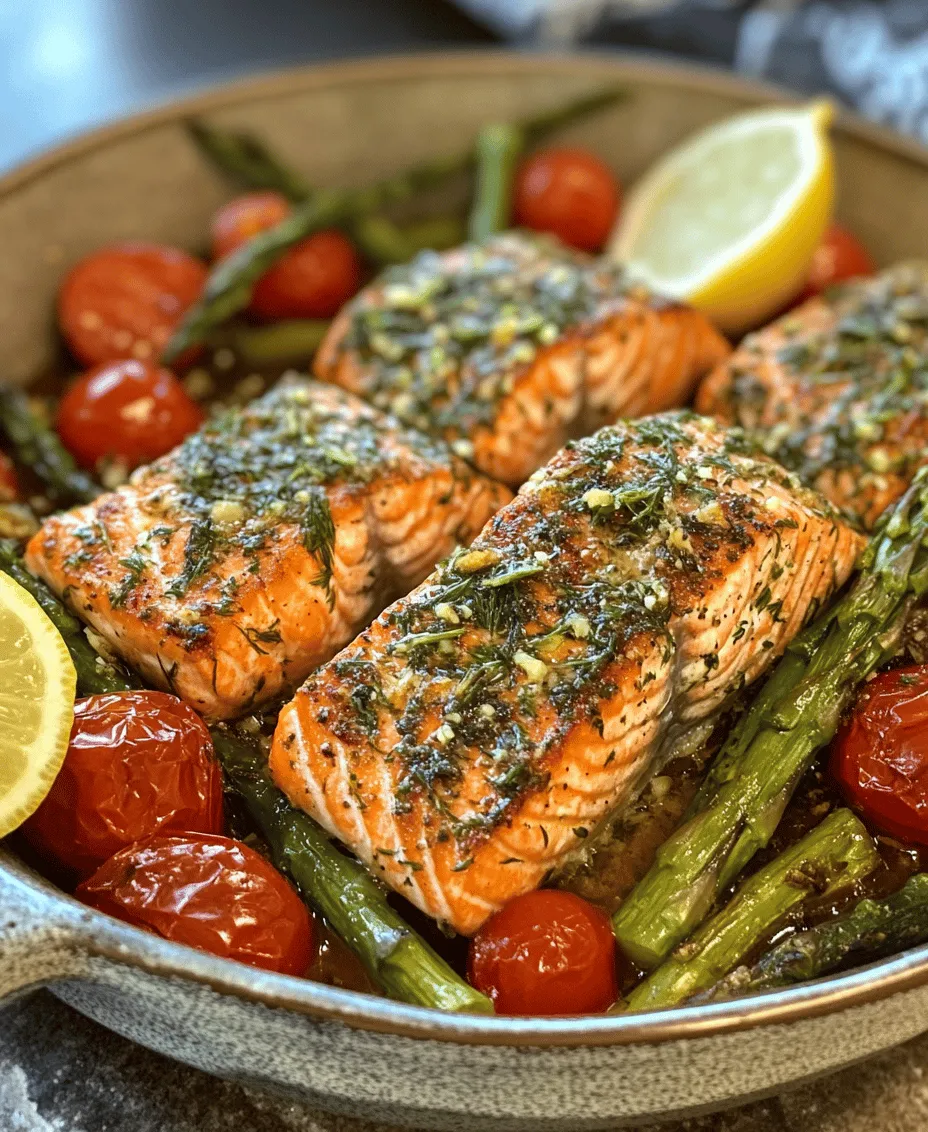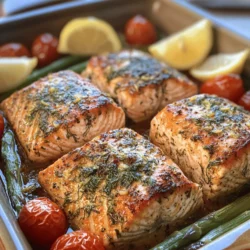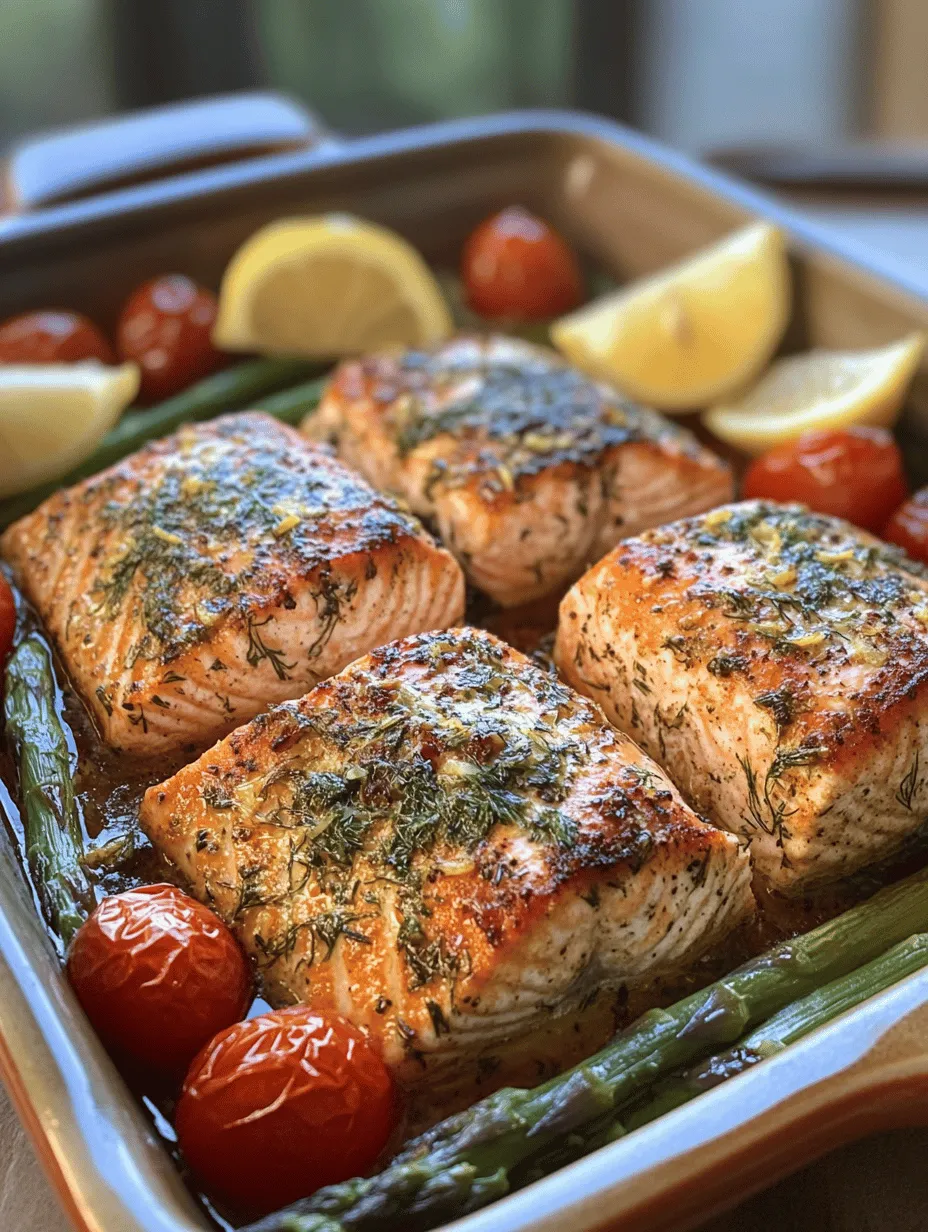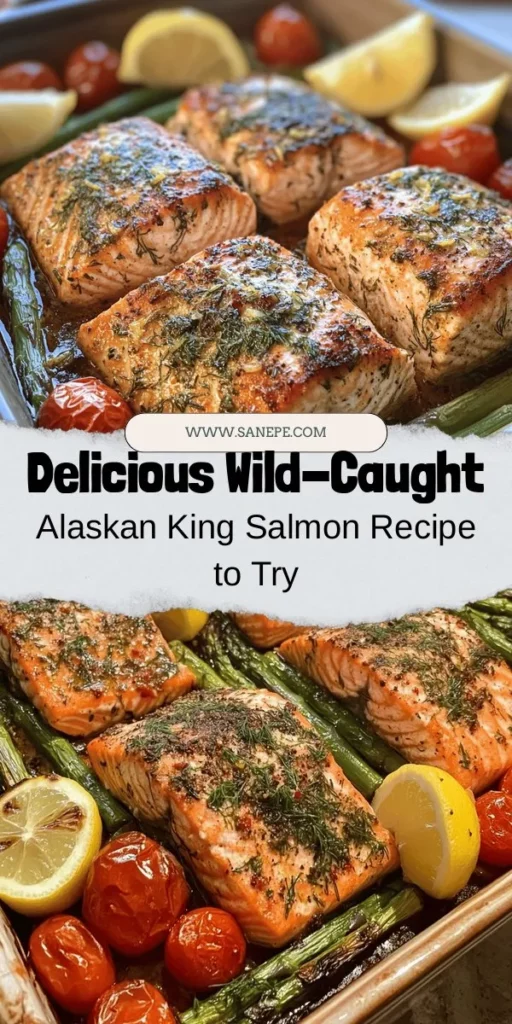Introduction
Alaskan King Salmon, also known as Oncorhynchus tshawytscha, is often hailed as the royalty of the salmon family. Renowned for its rich, buttery flavor and firm texture, this fish stands out in both taste and nutritional value. Wild-caught in the pristine waters of Alaska, King Salmon not only boasts a delicate balance of flavor and health benefits but also supports sustainable fishing practices. This recipe, “Savor the Shores: Wild-Caught Alaskan King Salmon Delight,” is a celebration of fresh, vibrant ingredients that come together in a dish that is both easy to prepare and packed with flavor.
In an age where health and sustainability are paramount, using wild-caught fish is an important choice. Not only does it ensure the fish is free from antibiotics and hormones commonly found in farmed fish, but it also supports ethical fishing methods that help maintain fish populations and their ecosystems. This recipe highlights the beauty of Alaskan King Salmon, showcasing how simple ingredients can elevate a meal while keeping it healthy and sustainable.
The Culinary Appeal of Alaskan King Salmon
The flavor profile of Alaskan King Salmon is truly exceptional. Unlike other salmon varieties, it has a pronounced richness that comes from its higher fat content, which contributes to its moistness and melt-in-your-mouth texture. With a deep, vibrant pink color, the fish is visually appealing and versatile, making it a favorite among chefs and home cooks alike.
Nutritionally, Alaskan King Salmon is a powerhouse. It is an excellent source of omega-3 fatty acids, which are known for their heart-healthy benefits. These essential fats play a crucial role in reducing inflammation and supporting brain health. Additionally, King Salmon is rich in high-quality protein, vitamins B12 and D, and selenium, making it a well-rounded choice for a nutritious meal.
Beyond its health benefits, Alaskan King Salmon also supports sustainability and ethical fishing practices. The wild-caught salmon fisheries in Alaska are carefully managed to ensure that fish populations remain healthy and that the ecosystem is preserved. By choosing wild-caught Alaskan King Salmon, you not only enjoy a superior product but also contribute to responsible fishing practices that protect our oceans and waterways.
Ingredients That Make a Difference
To truly savor the shores of Alaska, the ingredients in this dish must be of the highest quality. Here’s a list of key ingredients that will make this Alaskan King Salmon Delight shine:
– Wild-Caught Alaskan King Salmon: The star of the dish, providing unparalleled flavor and nutrient density.
– Olive Oil: A healthy fat that helps in the marinating process and enhances the salmon’s flavor. It adds a touch of richness while offering heart-healthy benefits.
– Fresh Lemon Juice: The acidity of lemon brightens the dish, cutting through the richness of the salmon and adding a refreshing zest.
– Herbs: Fresh herbs like dill or parsley not only enhance the flavor but also bring a burst of color to the plate. They provide a fragrant aroma that complements the fish beautifully.
– Seasonal Vegetables: Think asparagus, bell peppers, or zucchini. Incorporating seasonal produce not only boosts nutrition but also elevates the dish’s flavor and visual appeal.
Using fresh, high-quality ingredients is essential for achieving the best possible flavor and nutrition. The combination of Alaskan King Salmon with olive oil, lemon, and fresh herbs creates a delicious balance that is both satisfying and healthy.
Step-by-Step Preparation
Now that we have a grasp of the ingredients and their significance, let’s dive into the step-by-step preparation of this delightful dish.
Preheating the Oven
First and foremost, preheat your oven to 400°F (200°C). This step is crucial for ensuring that the salmon cooks evenly and retains its moisture. A properly preheated oven will create a perfect environment for roasting, allowing the natural fats in the salmon to render beautifully, enhancing the overall flavor of the dish.
Creating the Marinade
Next, we’ll prepare the marinade. The science behind marinating fish lies in the balance of flavors and the tenderizing process. In a medium bowl, combine approximately ¼ cup of olive oil, the juice of one fresh lemon, a pinch of salt, and freshly cracked black pepper. You can also add minced garlic or your choice of herbs at this point. The acidity from the lemon juice not only enhances the flavor but also helps to break down the proteins, making the salmon even more tender.
Marinating the Salmon
Once the marinade is ready, place your wild-caught Alaskan King Salmon fillet in a shallow dish. Pour the marinade over the salmon, ensuring that it’s evenly coated. For optimal flavor, let the salmon marinate for at least 15 to 30 minutes. This time frame allows the flavors to penetrate the fish, resulting in a more flavorful and succulent dish. While marinating, the salmon will absorb the lemony goodness, making each bite a burst of refreshing flavor.
Preparing the Vegetables
While the salmon marinates, take the opportunity to prepare your seasonal vegetables. Choose a mix that complements the salmon, such as asparagus, bell peppers, or zucchini. Wash and cut them into uniform pieces to ensure even cooking. Toss the vegetables in a little olive oil, salt, and pepper, ensuring they’re lightly coated. Fresh vegetables not only add nutritional value but also create a colorful contrast against the rich salmon.
Arranging Ingredients for Optimal Cooking
After marinating the salmon and preparing the vegetables, it’s time to arrange everything for optimal cooking. On a large baking sheet lined with parchment paper or lightly greased, place the marinated salmon fillet in the center. Surround it with the prepared vegetables, arranging them evenly to ensure they cook uniformly. This setup not only looks appealing but also allows the flavors to mingle as they roast together.
In this part of the recipe, we’ve laid the foundation for a delicious and healthy meal, highlighting the unique qualities of Alaskan King Salmon and the importance of fresh ingredients. The next steps will guide you through the cooking process, ensuring a perfectly executed dish that showcases the beauty of the Alaskan shores.
Stay tuned for the continuation of this recipe, where we will explore the cooking methods and finishing touches that will elevate your Alaskan King Salmon Delight to new heights.

Baking to Perfection
To achieve the luscious, flaky texture characteristic of Wild-Caught Alaskan King Salmon, it is essential to create ideal baking conditions. Preheat your oven to 400°F (200°C), ensuring it reaches a stable temperature before placing the salmon inside. A hot oven allows the fish to cook evenly, ensuring a moist interior while developing a subtle crust on the outside.
When baking salmon alongside vegetables, consider the timing. If you’re using denser vegetables like carrots or potatoes, give them a head start in the oven for about 10-15 minutes before adding the salmon. This way, everything finishes cooking at the same time, allowing the salmon to soak up some of the vegetable flavors without overcooking.
Signs of doneness are crucial to perfecting this dish. For salmon, look for an internal temperature of 145°F (63°C). The flesh should appear opaque and easily flake with a fork. Additionally, the edges will slightly curl, and a light white protein called albumin may surface, indicating it’s time to take it out. Remember, residual heat will continue to cook the salmon once removed from the oven, so err on the side of caution to prevent it from becoming dry.
Resting time post-baking is essential for flavor enhancement. Allow the salmon to rest for about 5 minutes after you take it out of the oven. This resting period helps redistribute the juices, ensuring that each bite is tender and flavorful. During this time, you can finalize your plating or prepare your side dishes, making the most of this brief wait.
Serving Suggestions
When it comes to serving your Wild-Caught Alaskan King Salmon, there are countless side dishes that can elevate your meal. Consider pairing it with a fluffy quinoa salad, mixed with fresh herbs, citrus, and vegetables for a refreshing contrast. Alternatively, roasted asparagus or sautéed spinach adds vibrant color and nutrients to the plate, complementing the rich flavor of the salmon.
For a heartier side, consider preparing a wild rice pilaf with nuts and dried fruits. This dish not only adds texture but also balances the meal with its earthy flavors. Presentation is key to making your meal visually appealing. Use a large white plate to allow the vibrant colors of the salmon and vegetables to stand out. Arrange the salmon fillet slightly off-center, and artfully place the sides around it, garnishing with fresh herbs or a slice of lemon for a pop of color.
Wine pairings can significantly enhance the dining experience. A crisp white wine, such as a Sauvignon Blanc or a lightly oaked Chardonnay, pairs beautifully with the richness of the salmon. If you prefer red, opt for a light Pinot Noir that won’t overpower the delicate flavors of the dish. A well-chosen wine can elevate the meal and create a memorable dining experience.
Health Benefits of the Dish
Wild-Caught Alaskan King Salmon is not only delicious but also packed with health benefits. Rich in Omega-3 fatty acids, this fish contributes to heart health, reduces inflammation, and supports cognitive function. A typical serving of salmon provides a bounty of essential nutrients, including high-quality protein, B vitamins, and selenium.
Incorporating fish into your diet is essential for a balanced lifestyle. The American Heart Association recommends consuming fish at least twice a week, highlighting its role in reducing the risk of heart disease and stroke. Furthermore, fish is a great alternative to red meat, offering protein without the saturated fat.
The health advantages extend to the fresh, organic vegetables you choose to accompany your salmon. Opting for seasonal, locally sourced produce ensures maximum nutrient retention and flavor. Organic vegetables often contain fewer pesticides, making them a healthier choice for you and the environment. By prioritizing fresh ingredients, you not only nourish your body but also contribute to sustainable farming practices.
Culinary Variations and Adaptations
One of the joys of cooking is the ability to adapt recipes according to your preferences and what you have on hand. If you’re looking to substitute the salmon, consider other fatty fish like trout or mackerel, which also offer rich flavors and health benefits. For a vegetarian twist, try marinated tofu or tempeh, baked in a similar manner to absorb the flavors of your chosen seasonings.
When it comes to vegetables, feel free to experiment based on what’s in season. Summer squash, bell peppers, and Brussels sprouts can all be delicious additions. If you prefer a spicier kick, consider adding jalapeños or a dash of cayenne to your vegetable mix.
Flavor variations can also transform this dish. Fresh herbs like dill, parsley, or cilantro can brighten the meal, while spices such as paprika or cumin can introduce a warm depth. For a Mediterranean flair, consider adding olives, capers, or sun-dried tomatoes to the baking dish.
Seasonal adaptations are a fantastic way to keep your meals exciting. In the fall, pair your salmon with roasted root vegetables like parsnips and sweet potatoes. In the winter, look for hearty greens like kale or collard greens, which can be sautéed with garlic for a robust side.
Conclusion
The Wild-Caught Alaskan King Salmon Delight is not just a meal; it’s an experience that brings the flavors of the ocean to your table. With its rich taste and flaky texture, this dish exemplifies the best of what fresh, sustainable ingredients can offer. The process of baking to perfection, serving with thoughtful sides, and understanding the health benefits makes it a well-rounded choice for any occasion.
As you explore the versatility of this recipe, you’re encouraged to make it a regular part of your meal rotation. By incorporating fresh fish and organic vegetables into your diet, you embrace not only a healthier lifestyle but also the joys of cooking with high-quality ingredients. The flavors are not just delightful; they nourish your body and invigorate your culinary creativity. Enjoy the journey of cooking and the delicious rewards that come with it.


